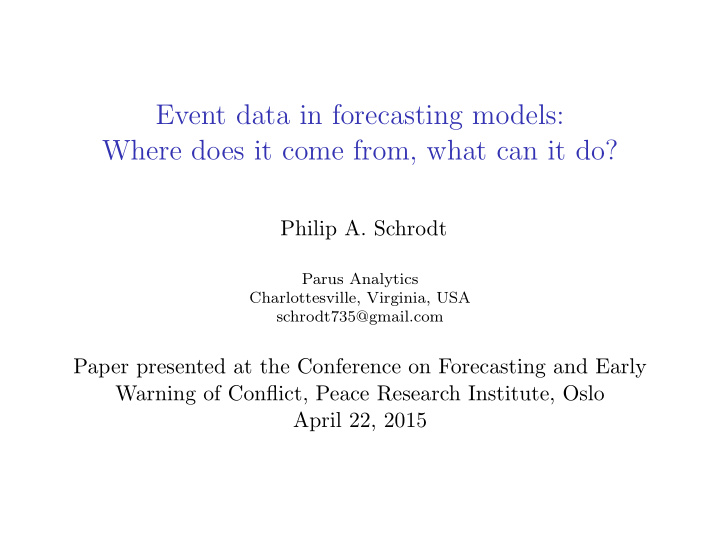



Event data in forecasting models: Where does it come from, what can it do? Philip A. Schrodt Parus Analytics Charlottesville, Virginia, USA schrodt735@gmail.com Paper presented at the Conference on Forecasting and Early Warning of Conflict, Peace Research Institute, Oslo April 22, 2015
Why is event data suddenly attracting attention after 50 years? ◮ Rifkin [NYT March 2014]: The most disruptive technologies in the current environment combine network effects with zero marginal cost ◮ Key: zero marginal costs even though open source software is still “free-as-in-puppy” ◮ Examples ◮ Operating systems: Linux ◮ General purpose programming: gcc, Python ◮ Statistical software: R ◮ Encyclopedia: Wikipedia ◮ Scientific typesetting and presentations: L A T EX
EL:DIABLO Event Location: Dataset in a Box, Linux Option ◮ Open source: https://openeventdata.github.io ◮ Full modular open-source pipeline to produce daily event data from web sources. http://phoenixdata.org ◮ Scraper from white-list of RSS feeds and web pages ◮ Event coding from any of several coders: TABARI, PETRARCH, others ◮ Geolocation: “Cliff” open source geolocater ◮ “One-A-Day” deduplication keeping URLs of all duplicates ◮ Designed for implementation in inexpensive Linux cloud systems ◮ Supported by Open Event Data Alliance http://openeventdata.org
An incident must first generate one or more texts This is the biggest challenge to accuracy. At least the following factors are involved ◮ A reporter actually witnesses, or learns about, the incident ◮ An editor thinks incident is “newsworthy”: This has a bimodal distribution of routine incidents such as announcements and meeting, and high-intensity incidents: “when it bleeds, it leads.” ◮ Report is not formally or informally censored ◮ Report corresponds to actual events, rather than being created for propaganda or entertainment purposes ◮ News coverage is biased towards the coverage of certain geographical regions, and generally “follows the money” ◮ Reports will be amplified if they are repeated in additional sources
Humans use multiple sources to create narratives ◮ Redundant information is automatically discarded ◮ Sources are assessed for reliability and validity ◮ Obscure sources can be used to “connect the dots” ◮ Episodic processing in humans provides a pleasant dopamine hit when you put together a “median narrative”: this is why people read novels and watch movies.
Machines latch on to anything that looks like an event
This must be filtered
Implications of one-a-day filtering ◮ Expected number of correct codes from a single incident increases exponentially but is asymptotic to 1 ◮ Expected number of incorrect codings increases linearly and is bounded only by the number of distinct codes Tension in two approaches to using machines [Isaacson] ◮ “Artificial intelligence” [Turing, McCarthy]: figure out how to get machines to think like humans ◮ “Computers are tools” [Hopper, Jobs]: Design systems to optimally complement human capabilities
Does this affect the common uses of event data? ◮ Trends and monitoring: probably okay, at least for sophisticated users ◮ Narratives and trigger models: a disaster ◮ Structural substitution models: seem to work pretty well because these are usually based on approaches that extract signal from noise ◮ Time series models: also work well, again because these have explicit error models ◮ Big Data approaches: who knows?
Weighted correlation between two data sets A − 1 A n i,j � � wtcorr = N r i,j (1) i =1 j = i where ◮ A = number of actors; ◮ n i,j = number of events involving dyad i,j ◮ N = total number of events in the two data sets which involve the undirected dyads in A x A ◮ r i,j = correlation on various measures: counts and Goldstein-Reising scores
Correlations over time: total counts and Goldstein-Reising totals
Correlations over time: pentacode counts
Dyads with highest correlations
Dyads with lowest correlations
What is to be done: Part 1 ◮ Open-access gold standard cases, then use the estimated classification matrices for statistical adjustments ◮ Systematically assess the trade-offs in multiple-source data, or create more sophisticated filters ◮ Evaluate the utility of multiple-data-set methods such as multiple systems estimation ◮ Systematic assessment of the native language versus machine translation issue ◮ Extend CAMEO and standardize sub-state actor codes: canonical CAMEO is too complicated, but ICEWS substate actors are too simple
What is to be done: Part 2 ◮ Automated verb phrase recognition and extraction: this will also be required to extend CAMEO. Entity identification, in contrast, is largely a solved problem (ICEWS: 100,000 actors in dictionary) ◮ Establish a user-friendly open-source collaboration platform for dictionary development ◮ Systematically explore aggregation methods: ICEWS has 10,742 aggregations, which is too many ◮ Solve—or at least improve upon—the open source geocoding issue ◮ Develop event-specific coding modules
Thank you Email: schrodt735@gmail.com Slides: http://eventdata.parusanalytics.com/presentations.html Data: http://phoenixdata.org Software: https://openeventdata.github.io/ Papers: http://eventdata.parusanalytics.com/papers.html
Recommend
More recommend